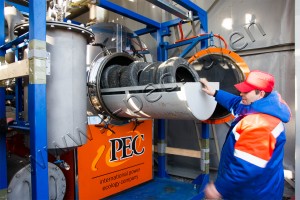Disposal of scrap tires
Industrial progress, the emergence of new manufacturing facilities will inevitably lead to an increase of industrial and household wastes. A significant part of it consists of rubber waste: gaskets, hoses, conveyor belts, rubber rugs, protective clothing, etc. But the major environmental challenge is used tires. More than 1 million tons of used tires annually produced only in Russia! In Europe this figure rises to 2.5 million tons, in the United States – up to 3 million tons.
Scrap rubber recycling makes up only 10 % of the rubber waste stream generated in the world. Much of these used tires then becomes landfilled and poses a potential environmental hazard! In natural conditions the decomposition of tyre waste exceeds 100 years with a release of various chemicals that poison the soil and groundwater. Scrap tires are inflammable; their fire leads to the release of highly toxic substances into the atmosphere: biphenyl, anthracene, pyrene and others.
At the same time, rubber goods are valuable raw material containing hydrocarbons and high-quality metal. Taking into account the growth of industrial demand for natural resources, and exhaustibility of the last, it is important to note that tire and rubber recycling is of great ecological and economic significance for all developed countries.
Waste tires conversion technologies
Today in the world a broad range of technologies are recognized to convert a wide variety of scrap tires as well as other hydrocarbon feedstock in the waste stream into usable products.
Specifically, they are classified as physical and chemical.
Of these classifications, physical technology is segmented into three categories:
• Mechanical recycling
• Low temperature processing
• Destruction and compression recycling
Chemical technology is segmented into two categories:
• Ozone recycling
• Pyrolysis recycling
Each technology mentioned above produces two main outputs:
1. Crumb rubber
2. Tire-derived fuel (TDF)
Crumb rubber is used for both paving and molded products such as rubberized asphalt concrete for road uses, playground cover mats and acoustic barriers for construction and industrial uses.
Alternative conversion technology products available per process used are segmented into three forms: liquid, solid and gaseous. Thus, tire-derived fuel (TDF) can be used for utilities, industrial boilers and co-generation plants; carbon black, which is recovered from the char, can be sent to an incinerator, or burned on site for additional energy recovery.
The value of the output products depends on the type of tires used as a feedstock and the specific process requirements.
Waste tires to crumb rubber
- mechanical recycling
Mechanical recycling as favorable waste management option for scrap tires focuses on bead rings, tyre crushing, steel cord separation and subsequent rubber grinding. This technology is based on the principle of increasing fragility of rubber at high-speed collisions.
Disadvantages of this technology are high energy consumption, rapid wearing of equipment and number of contaminating impurity in crumbs due to crude treatment.
- low-temperature processing
Low-temperature (cryogenic) process is a rubber cooling to 90 degrees, making it crack-sensitive. Cooling facilitates the grinding process, consumes less energy, and easily separates steel and textile.
Disadvantages of this technology are high cost of coolant (liquid nitrogen), power consumption, and delivery complexity.
- destruction and compression recycling
The technology is based on flowage of rubber through the holes in the high pressure chamber, with the separation of steel cord, and formation of textile and rubber crumb.
Disadvantages of this technology are high power consumption, rapid wearing of equipment, and multistage crumb rubber cleaning from inclusions of textile cord and steel.
- ozone recycling technology
The technology is based on instant oxidation of rubber that leads to the destruction of intermolecular and intramolecular bonds. The process used to dust the tire by ozone with subsequent dispersal into the rubber crumb. Thus, steel and textile cords are completely separated. Shredding is greatly speeded up and requires less energy consumption.
Disadvantages of this technology are high explosive risk, expensive equipment, the highest hazard class of ozone.
Waste tires to fuel
- pyrolysis technology
As a thermal conversion process the pyrolysis technology is characterized by higher temperatures, conversion rates and continuum of processes ranging from thermal decomposition of rubber without addition of any reactive gases, such as air or oxygen. The pyrolysis process transforms scrap tires into a valuable commodity and creates renewable sources of energy. Tire-to-fuel technologies handle used tires through a process of thermal treatment to convert them into a fuel product: synthetic gas, oil and carbon black. The resultant pyrolysis gases can be used for energy production, fuels or chemical production, which significantly reduces the power consumption for processing – energy is only required during startup and emergency situations.
Tire-to-fuel pyrolysis technology is one of the most environmentally friendly, energy and cost efficient options for treating a wide variety of rubber products in the waste stream. This technology is used in the most developed countries such as the USA, Japan, Germany, Switzerland and others.
When using the material or any part of it the link to the website (www.i-pec.ru) is required.


